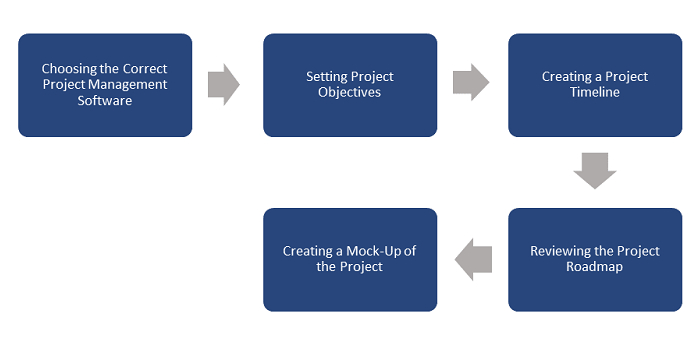
 Data Structure
Data Structure Networking
Networking RDBMS
RDBMS Operating System
Operating System Java
Java MS Excel
MS Excel iOS
iOS HTML
HTML CSS
CSS Android
Android Python
Python C Programming
C Programming C++
C++ C#
C# MongoDB
MongoDB MySQL
MySQL Javascript
Javascript PHP
PHP
- Selected Reading
- UPSC IAS Exams Notes
- Developer's Best Practices
- Questions and Answers
- Effective Resume Writing
- HR Interview Questions
- Computer Glossary
- Who is Who
How to Make a Project Roadmap?
Project management requires a constant, structured flow of communication between internal and external stakeholders. It is essential for a project manager to define the goals and structure of a project and monitor the day-to-day tasks to ensure the project is running smoothly. A project roadmap helps the organization and the clients understand the progress of a project. It gives the team an idea of the ambitions behind the project and keeps the external stakeholders posted on the day-to-day details. This article will look at how one can create a project roadmap.
What is a Project Roadmap?
A project roadmap is a high-level strategic plan that provides a visual overview of the project. It defines the step-by-step procedure of how a project is to be completed to achieve the desired goals. A project manager carefully defines the milestones of a project, along with the resources, time, and manpower required to complete it. It also lays out the deliverables the external stakeholders will obtain from the project. A project roadmap consists of the following &mminus;
Project goals that are to be obtained by the project management team.
The flow of work during the project completion journey.
project schedule in order to allocate resources and finish the project within the time constraints.
Real-time updates on how the project is progressing.
Project milestones to identify the points at which the procedure might undergo a change.
Project deliverables to update the external stakeholders about the output.
Considerable risks can be faced during the project.
Smart contingency plans to handle the speedbumps and maintain efficiency.
Key contacts for task and resource dependency.
What Is the Difference Between a Project Plan and a Project Roadmap?
A project plan and a project roadmap are often seen as the same concept and can be confusing. While both are used to provide structure to the project, there is a difference between the two concepts. Here are the key differences between a project roadmap and a project plan ?
Basis |
Project Roadmap |
Project Plan |
|---|---|---|
Structure level |
A project roadmap is a high-level structure for a visual overview of the project. |
A project plan is a granular structure for a detailed overview of the project. |
Objective |
Project roadmaps are developed to provide internal and external stakeholders with project updates. |
Project plans are created to set a detailed plan for the completion of the project. |
Contents |
A project roadmap consists of the project goals, resources, dependencies, timeline, deliverables, and risks. |
A project plan consisting of various tasks and subtasks to be performed as per the allocated timeline for the completion of the project. |
How to Create a Project Roadmap?

Choosing the Correct Project Management Software
The choice of project management software has a direct impact on the efficiency of the project. The first and foremost step in creating a project roadmap is to choose the correct project management software. A good project management software is one that can act as per the requirements of the project and manages data from internal and external sources. With the right software, project managers can visualize the project structure and allocate resources optimally. It is easy to track the everyday progress of the project and incorporate any changes that are required midway. It is also an intuitive support for the project manager, as it can pull data from various sources and process it effectively.
Laying Out Clear Project Objectives
Clearly defined project objectives are crucial for any project's success. A project manager must define the project objectives in measurable terms for easy tracking of progress. A project roadmap must highlight the qualitative and quantitative objectives to be obtained at the end of the project. It must also highlight the priority levels of the objectives before tracking begins. Transparent deadlines and trackable objectives make it easier for the project tracking team to identify areas of lag.
Setting a Project Timeline
A successful project is one with an assigned deadline for each task. The absence of deadlines can hamper the productivity of the team. With a clearly defined timeline for the project, a project manager can track the tasks that are pending after the due date. It helps the team gear up and completes the project as per the time constraints of the external stakeholders. A project timeline also helps the managers follow up on any deliverables from the clients that are necessary for the completion of the project.
Creating a Mock-Up of the Project
A mock-up of a project is a dummy structure that visually represents the overall project. It helps the project manager to share his project plan with the team, along with deadlines and milestones. A project mock-up can also highlight the task dependencies within the team, organization, or among external stakeholders. It helps the project team perform their responsibilities, and the project manager can control the areas of weakness when the objectives are not met. Managers can also highlight the estimated time and manpower requirements, along with the risks that can delay the timeline, in a mock-up roadmap.
Reviewing the Project Roadmap
Once a structure is created for the project, the roadmap must be reviewed internally and externally. Team members can perform an initial review to check if the roadmap is meeting their set objectives as per the availability of resources. An initial review also gives the project manager a chance to place the right individuals for the right task as per their strengths. An external review can also be performed by the stakeholders who are receiving the end deliverables of the project. External stakeholders can review the roadmap to understand whether the set structure is meeting their expectations for project updates and outputs.
Conclusion
Project roadmaps are an essential element of any project's smooth completion and success. It is a relevant tool to get your internal and external stakeholders on the same page. A project roadmap must be easy to understand and should give an overall picture of the project to the clients. It must have room for incorporating any changes that can occur before, during, or after the project's completion. A project manager must create a foolproof project map for every project to ensure they are achieving the client's as well as the organization's goals.

